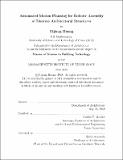| dc.contributor.advisor | Caitlin T. Mueller. | en_US |
| dc.contributor.author | Huang, Yijiang (Architect) Massachusetts Institute of Technology | en_US |
| dc.contributor.other | Massachusetts Institute of Technology. Department of Architecture. | en_US |
| dc.date.accessioned | 2018-10-15T18:37:11Z | |
| dc.date.available | 2018-10-15T18:37:11Z | |
| dc.date.copyright | 2018 | en_US |
| dc.date.issued | 2018 | en_US |
| dc.identifier.uri | http://hdl.handle.net/1721.1/118487 | |
| dc.description | Thesis: S.M. in Building Technology, Massachusetts Institute of Technology, Department of Architecture, 2018. | en_US |
| dc.description | This electronic version was submitted by the student author. The certified thesis is available in the Institute Archives and Special Collections. | en_US |
| dc.description | Cataloged from student-submitted PDF version of thesis. | en_US |
| dc.description | Includes bibliographical references (pages 71-80). | en_US |
| dc.description.abstract | Architectural robotics has proven a promising technique for assembling non-standard configurations of building components at the scale of the built environment, complementing the earlier revolution in generative digital design. However, despite the advantages of dexterity and precision, the time investment in solving the construction sequence and associated robotic motion grows increasingly with the topological complexity of the target design. This gap between parametric design and robotic fabrication congests the overall digital design/production process and often confines designers to geometries with standard topology. In the goal of filling this gap, this research presents a new robotic assembly planning framework called Choreo, which eliminates human-intervention for parts that are typically arduous and tedious in architectural robotics projects. Specifically, Choreo takes discrete spatial structure as input, and then assembly sequence, end effector pose, joint configuration, and transition trajectory are all generated automatically. Choreo embodies novelties in both algorithm design and software implementation. Algorithm-wise, a three-layer hierarchical assembly planning framework is proposed, to gradually narrow down the computational complexity along the deep and branched search tree emerging in this combined task and motion planning problem. Implementation-wise, Choreo's system architecture is designed to be modularized and adaptable, with the emphasis on being hardware-agnostic and forging a smooth integration into existing digital design-build workflow. Case studies on fabrication results of robotic extrusion (also called spatial 3D printing) are presented to demonstrate Choreo's power on efficiently generating feasible robotic instructions for assembling shapes with non-standard topology and across the scales. | en_US |
| dc.description.statementofresponsibility | by Yijiang Huang. | en_US |
| dc.format.extent | 80 pages | en_US |
| dc.language.iso | eng | en_US |
| dc.publisher | Massachusetts Institute of Technology | en_US |
| dc.rights | MIT theses are protected by copyright. They may be viewed, downloaded, or printed from this source but further reproduction or distribution in any format is prohibited without written permission. | en_US |
| dc.rights.uri | http://dspace.mit.edu/handle/1721.1/7582 | en_US |
| dc.subject | Architecture. | en_US |
| dc.title | Automated motion planning for robotic assembly of discrete architectural structures | en_US |
| dc.type | Thesis | en_US |
| dc.description.degree | S.M. in Building Technology | en_US |
| dc.contributor.department | Massachusetts Institute of Technology. Department of Architecture | |
| dc.identifier.oclc | 1054728184 | en_US |
